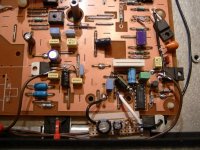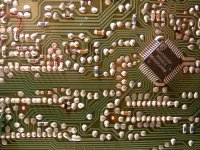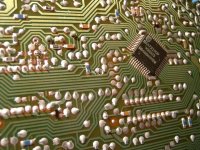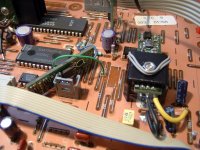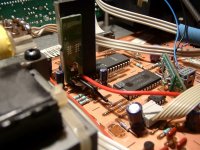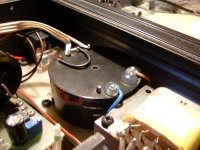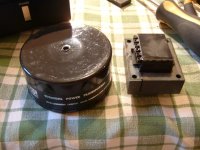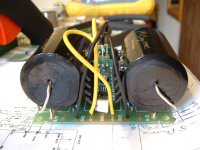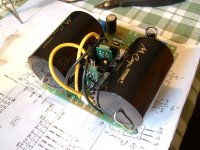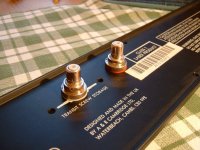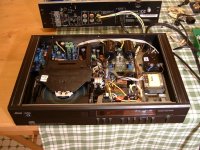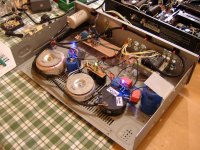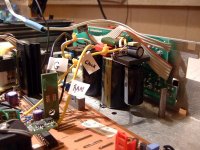Hi,
I noticed nobody has severely modified an Arcam Alpha on here so I thought I'd share my experiences with this machine. It's an early nineties (or very late 80s) player, must be one of the last using the TDA1541A DAC chip. It uses the SAA7220p/b digital filter and a QFP (surface-mount) SAA7310 decoder IC.
The servo section uses a big processor chip ("decoder up" according to the manual) and 4Mhz crystal, as well as a TDA5708/5709 under the mechanism, which is a CDM4/19. Most of the servo section runs from unregulated supplies. I don't know if the decoder uprocessor has much, if any, bearing on sound quality. I think it may.
The main board is a Philips job that Arcam have only partially stuffed. They added a blue "audio board" which features the DAC chip and output stage. This part also features power supplies for itself, and runs from a second "audio" transformer, which is a horrible little frame tx known for buzzing wildly when warmed up. It's something like 18-0-18VAC should you wish to change it.
The audio board uses 6 x 1000uF for psu smoothing, and uses LM317 and LM337 for the +15 (opamps and muting relay), -15V (opamps and DAC), -5V and +5V (DAC). The layout is neat, with the +-5V rails coming off the +-15V rails in series. The player uses relay muting, which I think is only used for power-up/down. The output stage is mediocre, using 2 single op-amps per channel. There are OP27 and then NE5534 at the output. There's an electrolytic cap for DC blocking. Offset on my player is about 800mV each side. I shorted these caps anyway as electrolytics shouldn't be in the signal path, ever if possible, and I have DC blocking later on in my system.
One interesting thing to note is that Arcam have used 0.47uF tantalum bead caps for the MSB "decoupling" on the TDA1541. The rest are 220nF polyester I believe. They are through-hole so easy to change if you so wish. I only changed the 4 at the MSB end which were tantals. I used 1uF and 0.47uF polyester, which just fit in the space.
The clocking is the typical affair - 11.2Mhz crystal feeds the SAA7220, which in turn distributes a noisy (so I'm led to believe) clock feed to the 7310 and the DAC. Pins 2 & 4 are joined on the DAC. Cosc (DEM pins) has a nice-looking cap (could it be MKP?) across it already. I swapped it for a 470pF polystyrene.
As standard, this is a great cd player. It has much of the usual coarse sound of an unmodified TDA1541 player, and a slightly hollow boxy bass. It also has the "magic", which many of use love to much in these old machines. There's that familiar chunky quality to all instruments and voices, and a lovely dynamic attack. Compared to the few other 1541 players I've heard (Philips CD650 below it) it ranks somewhere in the middle (CD94 is much sweeter and weightier, but more pricey). The difference can mainly be attributed to the power supplies. Much of the Alpha is good but the decoder, RAM, digital filter, microprocessor, servo chips etc. ALL run off one 7805. This is no good and the main reason the player sounds rough and not as detailed as it should. Also, the servo section is generally unregulated (unlike Marantz CD94), and this holds it back a bit.
We just need to fix some (many, to be honest) problems and it will sing beautifully.
Simon
I noticed nobody has severely modified an Arcam Alpha on here so I thought I'd share my experiences with this machine. It's an early nineties (or very late 80s) player, must be one of the last using the TDA1541A DAC chip. It uses the SAA7220p/b digital filter and a QFP (surface-mount) SAA7310 decoder IC.
The servo section uses a big processor chip ("decoder up" according to the manual) and 4Mhz crystal, as well as a TDA5708/5709 under the mechanism, which is a CDM4/19. Most of the servo section runs from unregulated supplies. I don't know if the decoder uprocessor has much, if any, bearing on sound quality. I think it may.
The main board is a Philips job that Arcam have only partially stuffed. They added a blue "audio board" which features the DAC chip and output stage. This part also features power supplies for itself, and runs from a second "audio" transformer, which is a horrible little frame tx known for buzzing wildly when warmed up. It's something like 18-0-18VAC should you wish to change it.
The audio board uses 6 x 1000uF for psu smoothing, and uses LM317 and LM337 for the +15 (opamps and muting relay), -15V (opamps and DAC), -5V and +5V (DAC). The layout is neat, with the +-5V rails coming off the +-15V rails in series. The player uses relay muting, which I think is only used for power-up/down. The output stage is mediocre, using 2 single op-amps per channel. There are OP27 and then NE5534 at the output. There's an electrolytic cap for DC blocking. Offset on my player is about 800mV each side. I shorted these caps anyway as electrolytics shouldn't be in the signal path, ever if possible, and I have DC blocking later on in my system.
One interesting thing to note is that Arcam have used 0.47uF tantalum bead caps for the MSB "decoupling" on the TDA1541. The rest are 220nF polyester I believe. They are through-hole so easy to change if you so wish. I only changed the 4 at the MSB end which were tantals. I used 1uF and 0.47uF polyester, which just fit in the space.
The clocking is the typical affair - 11.2Mhz crystal feeds the SAA7220, which in turn distributes a noisy (so I'm led to believe) clock feed to the 7310 and the DAC. Pins 2 & 4 are joined on the DAC. Cosc (DEM pins) has a nice-looking cap (could it be MKP?) across it already. I swapped it for a 470pF polystyrene.
As standard, this is a great cd player. It has much of the usual coarse sound of an unmodified TDA1541 player, and a slightly hollow boxy bass. It also has the "magic", which many of use love to much in these old machines. There's that familiar chunky quality to all instruments and voices, and a lovely dynamic attack. Compared to the few other 1541 players I've heard (Philips CD650 below it) it ranks somewhere in the middle (CD94 is much sweeter and weightier, but more pricey). The difference can mainly be attributed to the power supplies. Much of the Alpha is good but the decoder, RAM, digital filter, microprocessor, servo chips etc. ALL run off one 7805. This is no good and the main reason the player sounds rough and not as detailed as it should. Also, the servo section is generally unregulated (unlike Marantz CD94), and this holds it back a bit.
We just need to fix some (many, to be honest) problems and it will sing beautifully.
Simon
Mods
I changed most of the caps on the main board, and on the audio board. I changed the PSU diodes on the audio board only (schottky types). I used S Power regulation for the +5V and -15V rails for the DAC (-5V to follow). I used some old Audiocom Super Regs I had to power the RAM, digital filter, decoder and my clock, which is an Audioupgrades C1.
I used basic Sanyo os-cons for most digital decoupling, and os-con SEPC around the DAC. On the -15V rail I used Rubycon ZA.
I changed the DAC chip for a Taiwan-badged part that I think sounds better. I changed the MSB caps to 1uF, then 0.47uF for next-most-MSB.
On the servo I added 78/7912 regulators (installed flat for CDM clearance) to power the motor drive op-amp. I installed a 7912 and LM317 (configured for +12V) to power the TCA0372 (Focus drive and Radial drive op-amp). I installed a dedicated 7805 for the TDA8808/8809. I also installed decoupling caps where there were unused spaces on the PCB. Everything in this are must be quite flat to avoid fouling the mounting parts or swing-arm of the mech. See picture attached for example.
I changed most of the caps on the main board, and on the audio board. I changed the PSU diodes on the audio board only (schottky types). I used S Power regulation for the +5V and -15V rails for the DAC (-5V to follow). I used some old Audiocom Super Regs I had to power the RAM, digital filter, decoder and my clock, which is an Audioupgrades C1.
I used basic Sanyo os-cons for most digital decoupling, and os-con SEPC around the DAC. On the -15V rail I used Rubycon ZA.
I changed the DAC chip for a Taiwan-badged part that I think sounds better. I changed the MSB caps to 1uF, then 0.47uF for next-most-MSB.
On the servo I added 78/7912 regulators (installed flat for CDM clearance) to power the motor drive op-amp. I installed a 7912 and LM317 (configured for +12V) to power the TCA0372 (Focus drive and Radial drive op-amp). I installed a dedicated 7805 for the TDA8808/8809. I also installed decoupling caps where there were unused spaces on the PCB. Everything in this are must be quite flat to avoid fouling the mounting parts or swing-arm of the mech. See picture attached for example.
Attachments
I fed my new clock signal directly to the SAA7220 where the original xtal went. I the drilled a hole through the PCB to get a short wire through for the decoder, SAA7310. The blue zero-ohm resistor in the middle of the first picture below is where the original "Xsys" clock feed comes via from the 7220. I cut the trace after that and fed my new wire in.
A decent craft knife, 1-2mm drill bit and glue-gun should be recommended. You don't want to be going back under there too often to fix it if the wire breaks.
ps - you can't see the C1 clock because it's so closely mated to the super reg.
A decent craft knife, 1-2mm drill bit and glue-gun should be recommended. You don't want to be going back under there too often to fix it if the wire breaks.
ps - you can't see the C1 clock because it's so closely mated to the super reg.
Attachments
Audio tx upgrade
I chucked out the old buzzing audio section transformer, and installed a much larger potted Avel Lindberg toroid in its place. Luckily it was an easy straight swap and this alone made quite a large difference to sound quality. It gives that cleaner "toroidey" sort of sound (you could say slightly anaemic by comparison), but with welcome increased dynamic snap.
I chucked out the old buzzing audio section transformer, and installed a much larger potted Avel Lindberg toroid in its place. Luckily it was an easy straight swap and this alone made quite a large difference to sound quality. It gives that cleaner "toroidey" sort of sound (you could say slightly anaemic by comparison), but with welcome increased dynamic snap.
Attachments
The output section will be replaced by my Pass-designed "D1" stage, which uses quite nice parts. I somehow broke one of my S Power regulators, however, so need to fix that before I can use it. It runs of +-30V. I used this stage in my old Philips CD650 and absolutely loved it! The new output sockets are CMC silver over copper. About as good as they come and well worth the money.
Attachments
I've attached a recent picture of the player. The output stage, servo section, digital filter and decoder all have off-board supplies. The clock and RAM use new supplies in-player but with an off-board transformer. Past experience tells me there's something not right about using an off-board supply to power a clock. I had spurious noises in a previous player doing this 
There's about 400VA of transformers (4 toroids and 2 frame type) and maybe 120,000uF of smoothing powering the player now.
The clock psu is a bit of fun. I thought I'd bypass the 10,000uF smoothing cap and went overboard with: 4700uF, 330uF, 2.2uF, 330nF and 82nF. The sound did improve when I implemented this and the RAM psu so I can't say it doesn't work to some degree!
There's about 400VA of transformers (4 toroids and 2 frame type) and maybe 120,000uF of smoothing powering the player now.
The clock psu is a bit of fun. I thought I'd bypass the 10,000uF smoothing cap and went overboard with: 4700uF, 330uF, 2.2uF, 330nF and 82nF. The sound did improve when I implemented this and the RAM psu so I can't say it doesn't work to some degree!
Attachments
How does this one sound?
It's a bit early to comment on the sound quality because it's running the original NE5534 op-amps which leave a gritty hardness on the sound. When the D1 stage is going it will be rather different. As it is the sound is fairly smooth with huge dynamics and amazing-sounding drums. Detail levels are wonderful - each CD presents you with a wall of background noise, which isn't at all distracting, it's simply there. Stereo imaging is good I suppose, it's not something I'm interested in. This player begs you to turn up the volume and appreciate the sheer scale and impact of the music. Cello or female vocals can send shivers down my spine and acoustic guitar is wonderful - detailed and spacious.
It's a bit early to comment on the sound quality because it's running the original NE5534 op-amps which leave a gritty hardness on the sound. When the D1 stage is going it will be rather different. As it is the sound is fairly smooth with huge dynamics and amazing-sounding drums. Detail levels are wonderful - each CD presents you with a wall of background noise, which isn't at all distracting, it's simply there. Stereo imaging is good I suppose, it's not something I'm interested in. This player begs you to turn up the volume and appreciate the sheer scale and impact of the music. Cello or female vocals can send shivers down my spine and acoustic guitar is wonderful - detailed and spacious.
What else should be done?
I will need to send a clean clock feed to pins 2 and 4 of the DAC. I'm not sure exactly how this is going to work. I think my old player accepted 11.2Mhz on pin 2, or was it pin 4? I forget. I will eventually add a DEM (dynamic element matching?) clock feed across the two "Cosc" pins.
The output stage is a given.
I need some proper footwear on this player - wooden cones.
Eventually I'd also like to put in a double-crown DAC chip.
I need a proper low-noise voltage reg on the -5V DAC supply.
Otherwise, I think it's just about done. With the new output stage I'm confident it can't really be beaten. Vinyl, SACD etc., they're not really going to be better than this for my tastes - warm, rich thrilling detailed sound. I love the old-skool sound
I will need to send a clean clock feed to pins 2 and 4 of the DAC. I'm not sure exactly how this is going to work. I think my old player accepted 11.2Mhz on pin 2, or was it pin 4? I forget. I will eventually add a DEM (dynamic element matching?) clock feed across the two "Cosc" pins.
The output stage is a given.
I need some proper footwear on this player - wooden cones.
Eventually I'd also like to put in a double-crown DAC chip.
I need a proper low-noise voltage reg on the -5V DAC supply.
Otherwise, I think it's just about done. With the new output stage I'm confident it can't really be beaten. Vinyl, SACD etc., they're not really going to be better than this for my tastes - warm, rich thrilling detailed sound. I love the old-skool sound
Because I think anyone with an old TDA1541A-based player should know some of these albums, I'll list what I've been testing with:
Barb Jungr - Walking in the Sun
Carol Kidd - Debut
Eric Clapton - Unplugged
Stereophonics - Performance and Cocktails
Frank Black - Dog in the Sand
Jennifer Warnes - The Hunter
Diana Krall - From this Moment on
Diana Krall - The Girl in the Other Room
Jazz at the Pawnshop One
Andrew Lloyd Webber - Variations
If these albums don't sound stunning you probably need more mods
Barb Jungr - Walking in the Sun
Carol Kidd - Debut
Eric Clapton - Unplugged
Stereophonics - Performance and Cocktails
Frank Black - Dog in the Sand
Jennifer Warnes - The Hunter
Diana Krall - From this Moment on
Diana Krall - The Girl in the Other Room
Jazz at the Pawnshop One
Andrew Lloyd Webber - Variations
If these albums don't sound stunning you probably need more mods
Thanks Simonty for let us know your great job at this really good CD Player.
I bought three last week and will soon make some upgrades: capacitors, NETAudio NOS converter chip, NETAudio Rockclock and RCA output plugs.
Later I will go for power regulators upgrade and toroid (18-0-18?) instead of tx power suply.
Cruz
I bought three last week and will soon make some upgrades: capacitors, NETAudio NOS converter chip, NETAudio Rockclock and RCA output plugs.
Later I will go for power regulators upgrade and toroid (18-0-18?) instead of tx power suply.
Cruz
Thanks Simonty for let us know your great job at this really good CD Player.
I bought three last week and will soon make some upgrades: capacitors, NETAudio NOS converter chip, NETAudio Rockclock and RCA output plugs.
Later I will go for power regulators upgrade and toroid (18-0-18?) instead of tx power suply.
Cruz
Thanks Simonty for let us know your great job at this really good CD Player.
I bought three last week and will soon make some upgrades: capacitors, NETAudio NOS converter chip, NETAudio Rockclock and RCA output plugs.
Later I will go for power regulators upgrade and toroid (18-0-18?) instead of tx power suply.
Cruz
I wouldn't bother with the NOS converter chip. I bought one and never used it. If you want to go NOS it's as easy to do without the chip, just a few wire links needed.
Pete
Here what I have done to try my Arcam Alpha 5 in NOS mod:
I desolder the chip SAA7220P/B from board and lift the pins 1,2,3,15,16,18. Then I´ve joined the vacated holes with wire: 1 to 18 2 to 16 3 to 15.
After I cut the track between pins 4 to 2 of the TDA1541A chip, and connected the pin 4 to pin 5.
In the end of my work what I have it´s a CD player motor spinnig round like crazy!!!
I NEED SOME HELP PLEASE :-/
Cruz
I desolder the chip SAA7220P/B from board and lift the pins 1,2,3,15,16,18. Then I´ve joined the vacated holes with wire: 1 to 18 2 to 16 3 to 15.
After I cut the track between pins 4 to 2 of the TDA1541A chip, and connected the pin 4 to pin 5.
In the end of my work what I have it´s a CD player motor spinnig round like crazy!!!
I NEED SOME HELP PLEASE :-/
Cruz
Many thanks for your advice Mr. Pete about NOS mod. Would you please let me know what pins of SAA7220P/B and TDA1541A need to be linked, and what traces need to be cuted?
Grateful in advance for helping me,
Cruz
This is what I did.
Remove the SAA7220 chip completely.
In place of the chip, put wire links from the positions 1 to 18, 2 to 16 and 3 to 15 this routes the signal straight through to the dac.
Then you have to reroute the clock to the SAA7210 chip (I suspect this is the reason for your disc spinning). I don't completeley remember how I did this part, I think you just link the positions 11 and 9 where the 7220 was (routes the clock output through to 7210) and link the position 10 to leg 18 on the 7210 (feeds the drive output to the crystal from the 7210). Please double check this against the datasheets, I haven't done it for a while and I may have some of the references wrong.
An additional connection to get the muting working again is to link position 23 from the 7220 position to leg 11 of the 7210.
If your machine has the SAA7310 "A chip" instead of the SAA7210 the legs mentioned are different, you'd need to check the datasheet for the correct ones.
Hope this helps, regards
Pete
After I cut the track between pins 4 to 2 of the TDA1541A chip, and connected the pin 4 to pin 5.
Cruz
I don't think you need to do this for NOS. Not sure if it will cause a problem though.
- Status
- This old topic is closed. If you want to reopen this topic, contact a moderator using the "Report Post" button.
- Home
- Source & Line
- Digital Source
- Arcam Alpha mods
